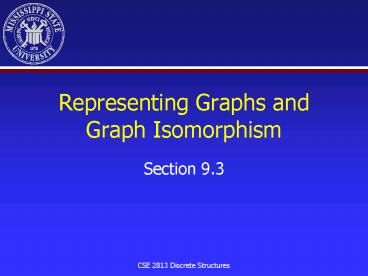Representing Graphs and Graph Isomorphism - PowerPoint PPT Presentation
1 / 14
Title:
Representing Graphs and Graph Isomorphism
Description:
... are isomorphic if ... Are G and H isomorphic? f(u1) = v1, f(u2) = v4, f(u3) = v3, ... properties that two simple graphs must have in common to be isomorphic ... – PowerPoint PPT presentation
Number of Views:96
Avg rating:3.0/5.0
Title: Representing Graphs and Graph Isomorphism
1
Representing Graphs andGraph Isomorphism
- Section 9.3
2
Adjacency Matrix
- A simple graph G (V,E) with n vertices can be
represented by its adjacency matrix, A, where the
entry aij in row i and column j is
3
Adjacency Matrix Example
0 1 0 0 1 1 1 0 1 0 0
1 0 1 0 1 0 1 0 0 1 0
1 1 1 0 0 1 0 1 1 1 1
1 1 0
4
Incidence Matrix
- Let G (V,E) be an undirected graph. Suppose
v1,v2,v3,,vn are the vertices and e1,e2,e3,,em
are the edges of G. The incidence matrix w.r.t.
this ordering of V and E is the n?m matrix M
mij, where
5
Incidence Matrix Example
- Represent the graph shown with an incidence
matrix.
1 1 0 0 0 0 0 0 1 1 0 1 0 0
0 0 1 1 1 0 1 0 0 0 0 1 0
1 1 0
6
Isomorphism
- Two simple graphs are isomorphic if
- there is a one-to one correspondence between the
vertices of the two graphs - the adjacency relationship is preserved
7
Isomorphism (Cont ..)
- The simple graphs G1(V1,E1) and G2(V2,E2) are
isomorphic if there is a one-to-one and onto
function f from V1 to V2 with the property that a
and b are adjacent in G1 iff f(a) and f(b) are
adjacent in G2, for all a and b in V1.
8
Example
Are G and H isomorphic? f(u1) v1, f(u2) v4,
f(u3) v3, f(u4) v2
9
Invariants
- Invariants properties that two simple graphs
must have in common to be isomorphic - Same number of vertices
- Same number of edges
- Degrees of corresponding vertices are the same
- If one is bipartite, the other must be if one is
complete, the other must be and others
10
Example
11
Example
- Are these two graphs are isomorphic?
- They both have 5 vertices
- They both have 8 edges
- They have the same number of vertices with the
same degrees 2, 3, 3, 4, 4.
12
Example (Cont..)
- Start with the vertices of degree 2 since each
graph only has one. - deg(u3) deg(v2) 2 therefore f(u3) v2
- Then consider vertices of degree 3
- deg(u1) deg(u5) deg(v1) deg(v4) 3
therefore we must have either one of - f(u1) v1 and f(u5) v4
- f(u1) v4 and f(u5) v1
13
Example (Cont..)
- Now try vertices of degree 4
- deg(u2) deg(u4) deg(v3) deg(v5) 4
therefore we must have either one of - f(u2) v3 and f(u4) v5
- f(u2) v5 and f(u4) v3
- There are four possibilities (can be messy )
- Try the first choices for f
- f(u1) v1, f(u5) v4, f(u2) v3, f(u4) v5
- Determine the adjacency matrices of G and H
14
Example (Cont..)
u1 u2 u3 u4 u5 u1 0 1 0 1 1 u2 1 0
1 1 1 u3 0 1 0 1 0 u4 1 1 1 0
1 u5 1 1 0 1 0
v1 v2 v3 v4 v5 v1 0 0 1 1 1 v2 0
0 1 0 1 v3 1 1 0 1 1 v4 1 0 1
0 1 v5 1 1 1 1 0
v1 v3 v2 v5 v4 v1 0 1 0 1 1 v3 1 0
1 1 1 v2 0 1 0 1 0 v5 1 1 1 0
1 v4 1 1 0 1 0
- Permute the adjacency matrix of H (per function
choices above) to see if we get the adjacency of
G. If we do, G and H are isomorphic.































